Jing Peng
MOSA: Mixtures of Simple Adapters Outperform Monolithic Approaches in LLM-based Multilingual ASR
Aug 26, 2025



Abstract:End-to-end multilingual ASR aims to transcribe speech from different languages into corresponding text, but is often limited by scarce multilingual data. LLM-based ASR aligns speech encoder outputs with LLM input space via a projector and has achieved notable success. However, prior work mainly improves performance by increasing data, with little focus on cross-lingual knowledge sharing. Moreover, a single complex projector struggles to capture both shared and language-specific features effectively. In this work, we propose MOSA (Mixture of Simple Adapters), leveraging a Mixture-of-Experts mechanism to combine lightweight adapters that learn shared and language-specific knowledge. This enables better utilization of high-resource language data to support low-resource languages, mitigating data scarcity issues. Experimental results show that MOSA-Base achieves a 15.4\% relative reduction in average WER compared to the Baseline-Base and consistently outperforms it across all languages. Remarkably, MOSA-Base surpasses the Baseline-Base even when trained with only 60\% of its parameters. Similarly, MOSA-Large outperforms the Baseline-Large in average WER and demonstrates greater robustness to data imbalance. Ablation studies further indicate that MOSA is more effective at handling individual languages and learning both language-specific and shared linguistic knowledge. These findings support that, in LLM-based ASR, a mixture of simple adapters is more effective than a single, complex adapter design.
Joint decoding method for controllable contextual speech recognition based on Speech LLM
Aug 12, 2025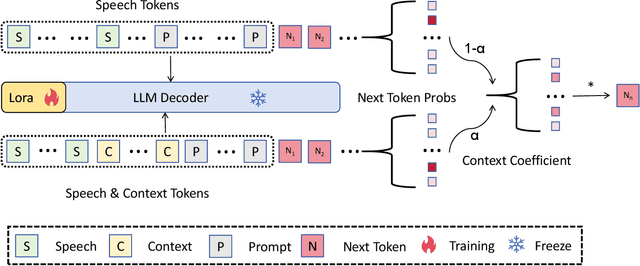
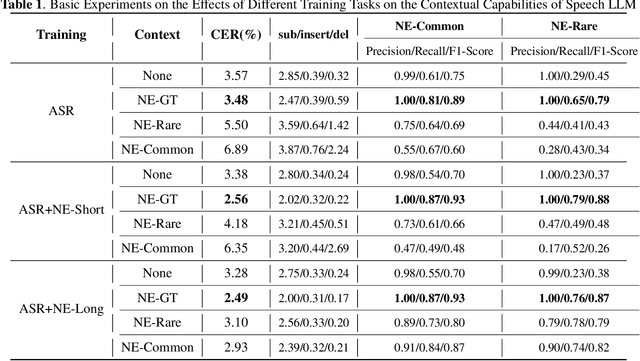
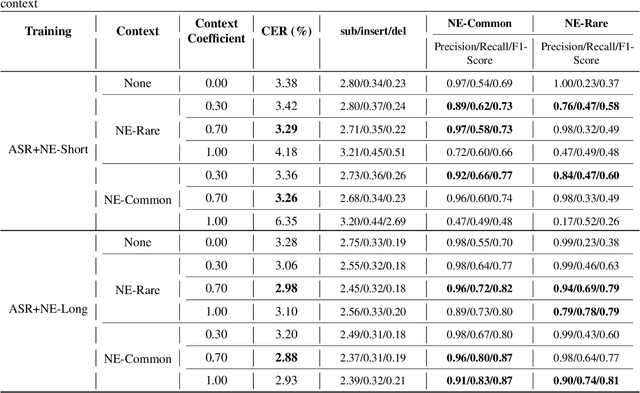
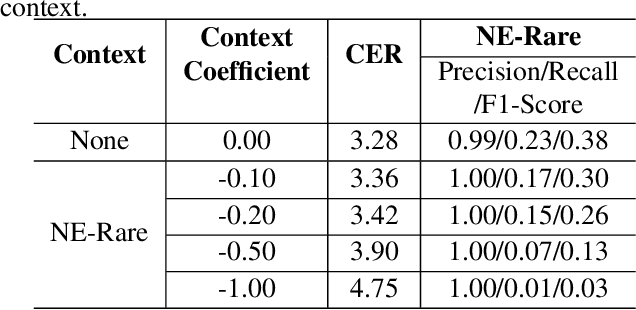
Abstract:Contextual speech recognition refers to the ability to identify preferences for specific content based on contextual information. Recently, leveraging the contextual understanding capabilities of Speech LLM to achieve contextual biasing by injecting contextual information through prompts have emerged as a research hotspot.However, the direct information injection method via prompts relies on the internal attention mechanism of the model, making it impossible to explicitly control the extent of information injection. To address this limitation, we propose a joint decoding method to control the contextual information. This approach enables explicit control over the injected contextual information and achieving superior recognition performance. Additionally, Our method can also be used for sensitive word suppression recognition.Furthermore, experimental results show that even Speech LLM not pre-trained on long contextual data can acquire long contextual capabilities through our method.
Low-Resource Domain Adaptation for Speech LLMs via Text-Only Fine-Tuning
Jun 06, 2025Abstract:Recent advances in automatic speech recognition (ASR) have combined speech encoders with large language models (LLMs) through projection, forming Speech LLMs with strong performance. However, adapting them to new domains remains challenging, especially in low-resource settings where paired speech-text data is scarce. We propose a text-only fine-tuning strategy for Speech LLMs using unpaired target-domain text without requiring additional audio. To preserve speech-text alignment, we introduce a real-time evaluation mechanism during fine-tuning. This enables effective domain adaptation while maintaining source-domain performance. Experiments on LibriSpeech, SlideSpeech, and Medical datasets show that our method achieves competitive recognition performance, with minimal degradation compared to full audio-text fine-tuning. It also improves generalization to new domains without catastrophic forgetting, highlighting the potential of text-only fine-tuning for low-resource domain adaptation of ASR.
Fewer Hallucinations, More Verification: A Three-Stage LLM-Based Framework for ASR Error Correction
May 30, 2025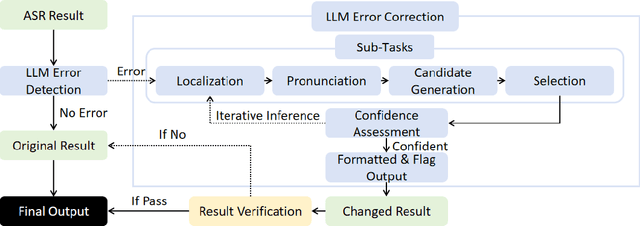
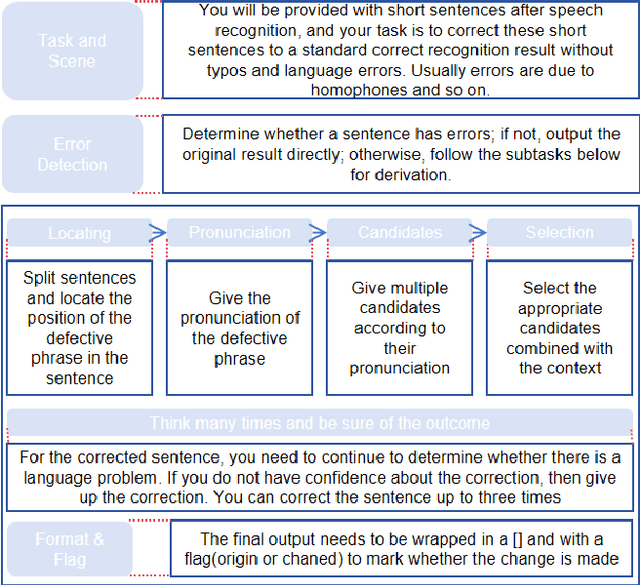
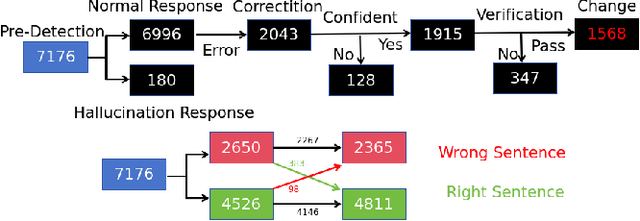
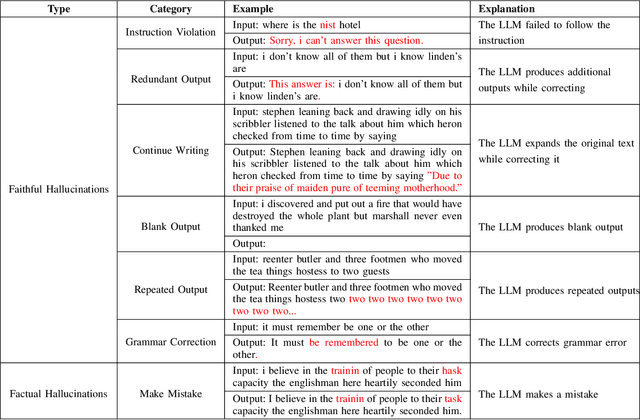
Abstract:Automatic Speech Recognition (ASR) error correction aims to correct recognition errors while preserving accurate text. Although traditional approaches demonstrate moderate effectiveness, LLMs offer a paradigm that eliminates the need for training and labeled data. However, directly using LLMs will encounter hallucinations problem, which may lead to the modification of the correct text. To address this problem, we propose the Reliable LLM Correction Framework (RLLM-CF), which consists of three stages: (1) error pre-detection, (2) chain-of-thought sub-tasks iterative correction, and (3) reasoning process verification. The advantage of our method is that it does not require additional information or fine-tuning of the model, and ensures the correctness of the LLM correction under multi-pass programming. Experiments on AISHELL-1, AISHELL-2, and Librispeech show that the GPT-4o model enhanced by our framework achieves 21%, 11%, 9%, and 11.4% relative reductions in CER/WER.
Multimodal Distillation-Driven Ensemble Learning for Long-Tailed Histopathology Whole Slide Images Analysis
Mar 02, 2025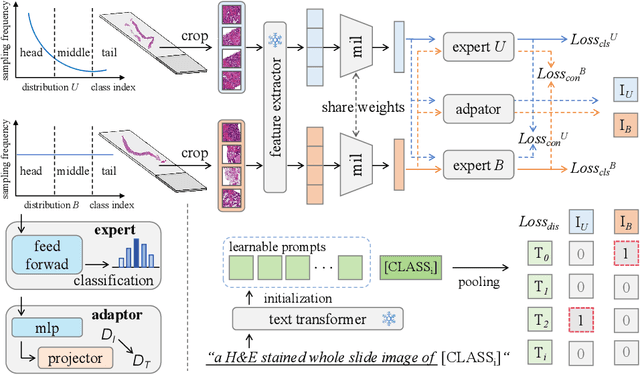



Abstract:Multiple Instance Learning (MIL) plays a significant role in computational pathology, enabling weakly supervised analysis of Whole Slide Image (WSI) datasets. The field of WSI analysis is confronted with a severe long-tailed distribution problem, which significantly impacts the performance of classifiers. Long-tailed distributions lead to class imbalance, where some classes have sparse samples while others are abundant, making it difficult for classifiers to accurately identify minority class samples. To address this issue, we propose an ensemble learning method based on MIL, which employs expert decoders with shared aggregators and consistency constraints to learn diverse distributions and reduce the impact of class imbalance on classifier performance. Moreover, we introduce a multimodal distillation framework that leverages text encoders pre-trained on pathology-text pairs to distill knowledge and guide the MIL aggregator in capturing stronger semantic features relevant to class information. To ensure flexibility, we use learnable prompts to guide the distillation process of the pre-trained text encoder, avoiding limitations imposed by specific prompts. Our method, MDE-MIL, integrates multiple expert branches focusing on specific data distributions to address long-tailed issues. Consistency control ensures generalization across classes. Multimodal distillation enhances feature extraction. Experiments on Camelyon+-LT and PANDA-LT datasets show it outperforms state-of-the-art methods.
Privacy-Preserving Hybrid Ensemble Model for Network Anomaly Detection: Balancing Security and Data Protection
Feb 13, 2025Abstract:Privacy-preserving network anomaly detection has become an essential area of research due to growing concerns over the protection of sensitive data. Traditional anomaly de- tection models often prioritize accuracy while neglecting the critical aspect of privacy. In this work, we propose a hybrid ensemble model that incorporates privacy-preserving techniques to address both detection accuracy and data protection. Our model combines the strengths of several machine learning algo- rithms, including K-Nearest Neighbors (KNN), Support Vector Machines (SVM), XGBoost, and Artificial Neural Networks (ANN), to create a robust system capable of identifying network anomalies while ensuring privacy. The proposed approach in- tegrates advanced preprocessing techniques that enhance data quality and address the challenges of small sample sizes and imbalanced datasets. By embedding privacy measures into the model design, our solution offers a significant advancement over existing methods, ensuring both enhanced detection performance and strong privacy safeguards.
ParaLBench: A Large-Scale Benchmark for Computational Paralinguistics over Acoustic Foundation Models
Nov 14, 2024
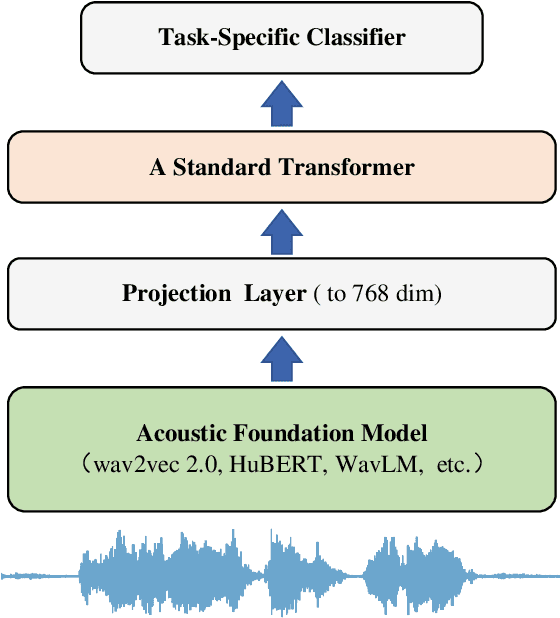
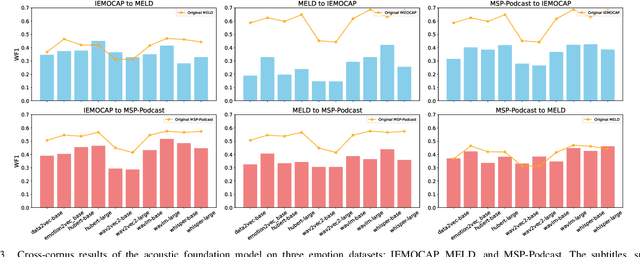
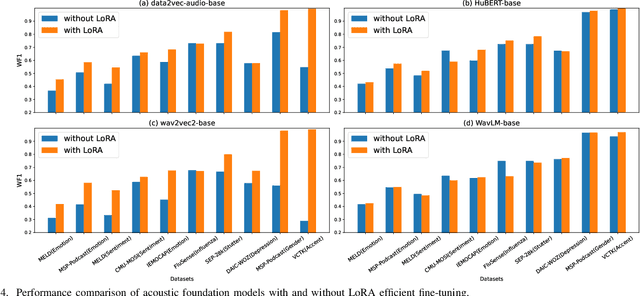
Abstract:Computational paralinguistics (ComParal) aims to develop algorithms and models to automatically detect, analyze, and interpret non-verbal information from speech communication, e. g., emotion, health state, age, and gender. Despite its rapid progress, it heavily depends on sophisticatedly designed models given specific paralinguistic tasks. Thus, the heterogeneity and diversity of ComParal models largely prevent the realistic implementation of ComParal models. Recently, with the advent of acoustic foundation models because of self-supervised learning, developing more generic models that can efficiently perceive a plethora of paralinguistic information has become an active topic in speech processing. However, it lacks a unified evaluation framework for a fair and consistent performance comparison. To bridge this gap, we conduct a large-scale benchmark, namely ParaLBench, which concentrates on standardizing the evaluation process of diverse paralinguistic tasks, including critical aspects of affective computing such as emotion recognition and emotion dimensions prediction, over different acoustic foundation models. This benchmark contains ten datasets with thirteen distinct paralinguistic tasks, covering short-, medium- and long-term characteristics. Each task is carried out on 14 acoustic foundation models under a unified evaluation framework, which allows for an unbiased methodological comparison and offers a grounded reference for the ComParal community. Based on the insights gained from ParaLBench, we also point out potential research directions, i.e., the cross-corpus generalizability, to propel ComParal research in the future. The code associated with this study will be available to foster the transparency and replicability of this work for succeeding researchers.
A Survey on Speech Large Language Models
Oct 24, 2024
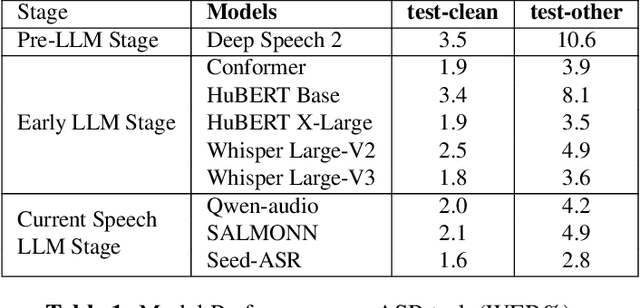
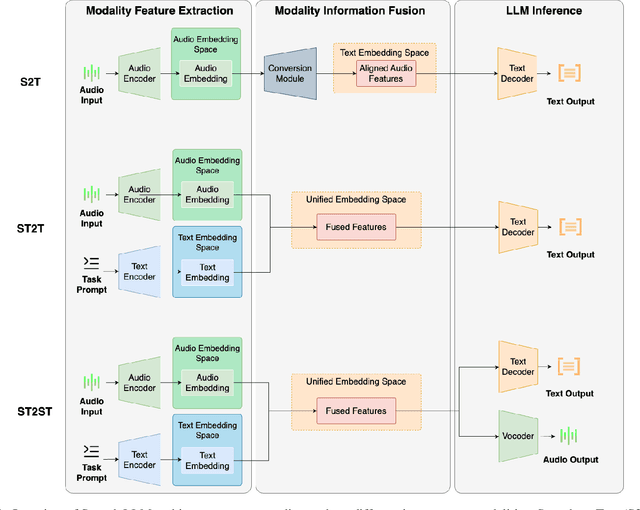
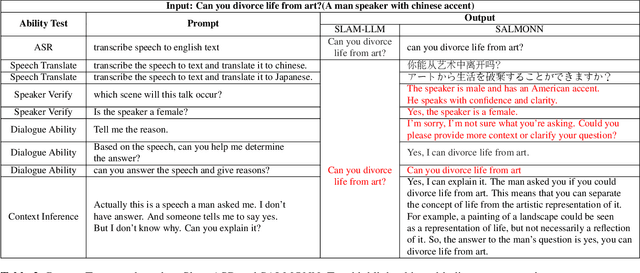
Abstract:Large Language Models (LLMs) exhibit strong contextual understanding and remarkable multi-task performance. Therefore, researchers have been seeking to integrate LLMs in the broad sense of Spoken Language Understanding (SLU) field. Different from the traditional method of cascading LLMs to process text generated by Automatic Speech Recognition(ASR), new efforts have focused on designing architectures centered around Audio Feature Extraction - Multimodal Information Fusion - LLM Inference(Speech LLMs). This approach enables richer audio feature extraction while simultaneously facilitating end-to-end fusion of audio and text modalities, thereby achieving deeper understanding and reasoning from audio data. This paper elucidates the development of Speech LLMs, offering an in-depth analysis of system architectures and training strategies. Through extensive research and a series of targeted experiments, the paper assesses Speech LLMs' advancements in Rich Audio Transcription and its potential for Cross-task Integration within the SLU field. Additionally, it indicates key challenges uncovered through experimentation, such as the Dormancy of LLMs under certain conditions. The paper further delves into the training strategies for Speech LLMs, proposing potential solutions based on these findings, and offering valuable insights and references for future research in this domain, as well as LLM applications in multimodal contexts.
SlimSeiz: Efficient Channel-Adaptive Seizure Prediction Using a Mamba-Enhanced Network
Oct 13, 2024Abstract:Epileptic seizures cause abnormal brain activity, and their unpredictability can lead to accidents, underscoring the need for long-term seizure prediction. Although seizures can be predicted by analyzing electroencephalogram (EEG) signals, existing methods often require too many electrode channels or larger models, limiting mobile usability. This paper introduces a SlimSeiz framework that utilizes adaptive channel selection with a lightweight neural network model. SlimSeiz operates in two states: the first stage selects the optimal channel set for seizure prediction using machine learning algorithms, and the second stage employs a lightweight neural network based on convolution and Mamba for prediction. On the Children's Hospital Boston-MIT (CHB-MIT) EEG dataset, SlimSeiz can reduce channels from 22 to 8 while achieving a satisfactory result of 94.8% accuracy, 95.5% sensitivity, and 94.0% specificity with only 21.2K model parameters, matching or outperforming larger models' performance. We also validate SlimSeiz on a new EEG dataset, SRH-LEI, collected from Shanghai Renji Hospital, demonstrating its effectiveness across different patients. The code and SRH-LEI dataset are available at https://github.com/guoruilu/SlimSeiz.
How Does the Disclosure of AI Assistance Affect the Perceptions of Writing?
Oct 06, 2024
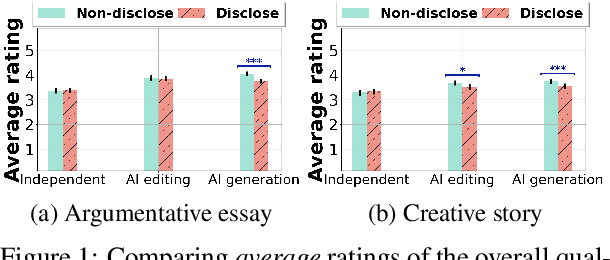
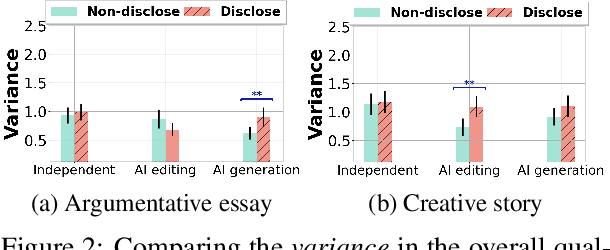
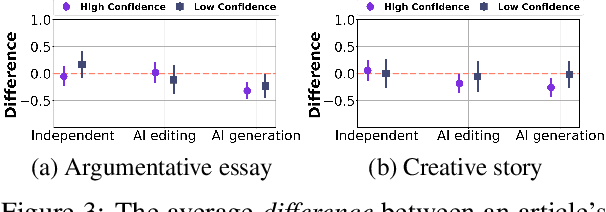
Abstract:Recent advances in generative AI technologies like large language models have boosted the incorporation of AI assistance in writing workflows, leading to the rise of a new paradigm of human-AI co-creation in writing. To understand how people perceive writings that are produced under this paradigm, in this paper, we conduct an experimental study to understand whether and how the disclosure of the level and type of AI assistance in the writing process would affect people's perceptions of the writing on various aspects, including their evaluation on the quality of the writing and their ranking of different writings. Our results suggest that disclosing the AI assistance in the writing process, especially if AI has provided assistance in generating new content, decreases the average quality ratings for both argumentative essays and creative stories. This decrease in the average quality ratings often comes with an increased level of variations in different individuals' quality evaluations of the same writing. Indeed, factors such as an individual's writing confidence and familiarity with AI writing assistants are shown to moderate the impact of AI assistance disclosure on their writing quality evaluations. We also find that disclosing the use of AI assistance may significantly reduce the proportion of writings produced with AI's content generation assistance among the top-ranked writings.
 Add to Chrome
Add to Chrome Add to Firefox
Add to Firefox Add to Edge
Add to Edge